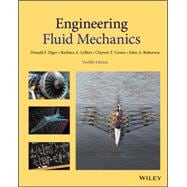Engineering Fluid Mechanics guides students from theory to application, emphasizing critical thinking, problem solving, estimation, and other vital engineering skills. Clear, accessible writing puts the focus on essential concepts, while abundant illustrations, charts, diagrams, and examples illustrate complex topics and highlight the physical reality of fluid dynamics applications. Over 1,000 chapter problems provide the "deliberate practice"—with feedback—that leads to material mastery, and discussion of real-world applications provides a frame of reference that enhances student comprehension.
The study of fluid mechanics pulls from chemistry, physics, statics, and calculus to describe the behavior of liquid matter; as a strong foundation in these concepts is essential across a variety of engineering fields, this text likewise pulls from civil engineering, mechanical engineering, chemical engineering, and more to provide a broadly relevant, immediately practicable knowledge base. Written by a team of educators who are also practicing engineers, this book merges effective pedagogy with professional perspective to help today’s students become tomorrow’s skillful engineers.








